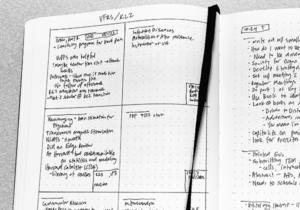Balancing on the Edge
As academics, most of us are in overdrive—racing from meetings to emails, writing to teaching, and maintaining some semblance of a balanced life.
Two fallacies about how we operate ourselves in overdrive:
- I can multitask: Multitasking is a misnomer.1 When we multitask, we are moving serially between tasks. This gives us the perception that we are accomplishing more. The downside of vacillating is that each task does not receive focused attention. Overall, our attention scatters producing a fragmented experience which tends to increase stress.
- I am in control: No, most of the time we are not in control of ourselves.2 Before you challenge this one, understand I believe in free will. However, on a moment to moment basis a majority of our actions, thoughts, words, and feelings are habitual responses from patterned experiences over a lifetime. We are running on autopilot most of the time. If we operate in overdrive, it is largely a patterned behavior.
So how can we be on the edge while maintaining balance? Some answers from Yoga.
Despite secular trends, yoga is associated more with philosophy than a type of pants. Yoga is defined by ability to focus the mind in a single direction. Two major objectives of yoga are to develop the capacity for sustained attention (AKA monotasking) and self-regulation (influence and awareness of self in relation to experience getting in control).
- Sustained attention is cultivated with two qualities: ease (i.e. effort with no physical or mental strain) and stability (effective focus with some penetration). Think Sherlock Holmes—he is highly attentive, which appears effortless (elementary), but is profound in quality.
- Self-regulation: Yoga proposes practices/exercises that change our habitual patterned behaviors. The proposal here is simple: To change patterns we need to create new experiences. New experiences will produce new patterns. If we repeatedly do these new practices, our old patterns (actions, thoughts, feelings etc.) will be replaced with new ones (hopefully better).
One very accessible practice is slow breathing techniques from Viniyoga (a style of yoga). Breathing is uniquely positioned as a largely involuntary process that we can voluntarily influence or guide. Breathing is highly susceptible to our mental state; when we’re agitated we breathe raggedly versus breathing slowly and deeply when we are calm. Yoga proposes consciously shifting our breathing pattern to shift our physical and mental state. Specifically, slow breathing with focused attention, ease, and stability produces a new experience that begins to shift our habitual patterns. While breath technique can become complex, beginning is quite simple:
- Close your eyes and place your hand on your lower abdomen.
- As you breathe, observe your abdomen move with the movement of your hand.
- Gradually make your breath deeper, but remember to breathe with both ease and stability.
- If you get short of breath, you are breathing too slowly past your comfort level. Adjust the length to stay comfortable. With gentleness and ease, the breath will lengthen over time without strain.
- If you are distracted, just redirect your mind back to your breath.
Try to work your way up to doing 24 breaths this way, and do it once a day.
Next, try to reflect on how the breathing practice makes you feel:
Observe how you feel before and immediately after a practice, and later in the day/night. When starting out, some find a journal useful to jot down some notes. Examples: How does my body feel? What was my breath like? Was I able to concentrate? Reflecting on your practice allows you to integrate the experience with the rest of your day. Yoga proposes that a regular practice of focused attention and self-regulation with slow breathing will gradually rewire our stressful habits and reactions to a more sustainable and self-controlled state.
For more information on breathing techniques from Viniyoga consider the following:
- Book: The Heart of Yoga by T.K.V. Desikachar3
- Online: Yoga Well Institute (http://www.yogawellinstitute.com): Online and in-person classes on breathing and other yoga techniques for balance and health.
References:
- von PFETTEN V. Read This Story Without Distraction (Can You?). New York Times 2016.
- Duhigg C. The power of habit: Why we do what we do in life and business. Vol 34: Random House; 2012.
- Desikachar T. The heart of yoga: Developing a personal practice. Inner Traditions International: Rochester, Vermont; 1999.
More Resources
Just Breathe: Mindfulness Apps in a Pressured Time
Finding Your Science Flow: Yoga Lessons to Increase Productivity
Building Resiliency with Hypnosis and Mindfulness





0 Comments